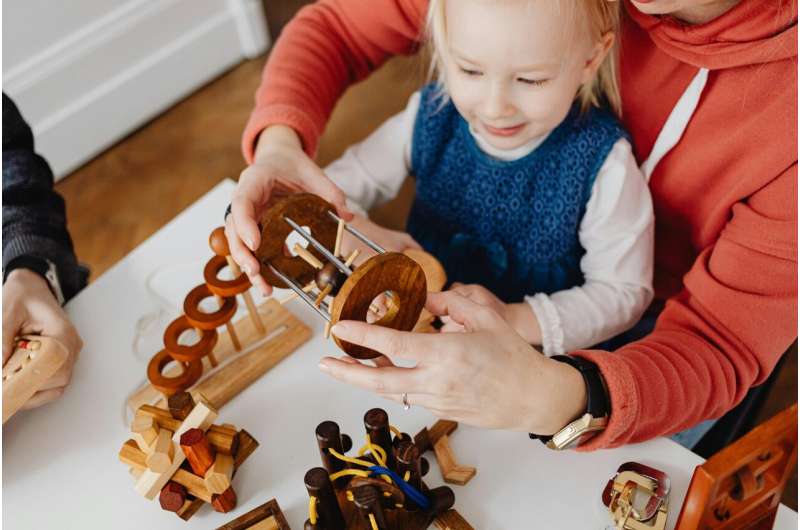English children lag behind in geometry, but parents can help them learn through play

Geometry is an important branch of mathematics, which we use to understand the properties of 2D and 3D space such as distance, shape, size and position. We use geometry every day: cutting paper to wrap a present, calculating the area of a room to tile a floor, and interpreting pie charts and bar graphs at work. Even noticing when a picture on the wall is askew draws on our geometrical understanding.
But although children in England compared to many countries, their are significantly below their . This pattern has held consistently for children in both year five (ages nine and ten) and year nine (ages 13–14) since 2015.
The solution might lie in improving children's spatial skills: something that could be done through activities as simple and fun as playing with jigsaws, toy cars or construction sets.
is the ability to understand the spatial properties of objects, such as their size and location, and to visualize objects and problems. Try, for instance, to picture a cube in your mind. How many sides does it have? You've just used spatial visualization skills to work it out.
Research consistently shows that children who are good at spatial thinking are , and that spatial training for math improvement.
Despite this, spatial thinking isn't an area of focus in schools. Instead, the current mathematics curriculum has a strong focus on number.
For example, the current geometry curriculum doesn't include visualization. Visualization is the ability to imagine and manipulate spatial information in the mind's eye. It is an aspect of spatial thinking which is . The inclusion of more spatial thinking would have benefits across the teaching of math. As well as being central to geometry, it helps with reading graphs, rearranging formulae and problem solving.
In the meantime, though, parents can help their children develop spatial skills at home. Here are some tips for pre-school and primary age children.
Spatial play
When doing a jigsaw, ask your child if they can turn the piece in their imagination, rather than trying different options with the real piece, to work out where it goes. This draws on .
Your child may well have received a craft kit, marble run or construction set for Christmas. Any toy like this with pictorial instructions—diagrams you have to follow to construct something—.
Encourage your child to look at the instructions and then back at their creation. This engages : the ability to maintain an image in memory for a small amount of time. This is important for holding numbers in mind during mathematical problem solving.
If your child likes playing with dollhouses, toy cars or toy farms, ask them about differences in scale—whether, for instance, a doll's hat would fit on their own head. You could ask them to draw a road for their toy cars, thinking about how big it will have to be to fit them.
This encourages the development of , a spatial skill that children can later employ when reasoning about proportions or working with fractions.
For pre-school children, simple activities like sorting teddies by size and labeling them "small," "medium," or "large," can build an early foundation for spatial reasoning.
While playing with your children, try to use spatial language—words such as "left," "right," "between," "in," "above"—to discuss what you are doing. When more spatial language, also use more spatial language—and children with stronger spatial language demonstrate . So, using these words will be beneficial for your children's mathematics development.
Some spatial words are more challenging than others. "Between" is hard for a four-year-old, and "increase" and "parallel" are better used with . To help your child understand these concepts, you can use your hands to demonstrate. Hand gestures provide a concrete representation of a spatial concept and help children visualize what a .
Encouraging quality spatial play is an easy and enjoyable way for parents to enlighten children to the spatial aspects of the world. Not only will this strengthen their spatial and mathematical skills, but it will also give them a solid foundation for future success, at school and beyond.
Provided by The Conversation
This article is republished from under a Creative Commons license. Read the .![]()



















